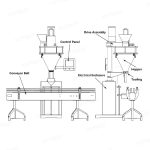Ghee filling machine selection guide, as the name implies, is how to choose the most suitable machine for filling ghee, this guide includes the following parts.
- What is ghee and what are its characteristics
- Common ghee packaging containers
- The choice of filling machine and why
- The choice of capping and labeling equipment
What is ghee and what are its characteristics
Ghee is made of butter, but modern vegetable shortening is sometimes called “vegetable ghee” and used for cooking, especially by vegans.
Ghee is typically prepared by simmering butter, which is churned from cream, skimming any impurities from the surface, then pouring and retaining the clear liquid fat while discarding the solid residue that has settled to the bottom. Spices can be added for flavour. The texture, colour, and taste of ghee depend on the quality of the butter, the milk source used in the process, and the duration of boiling time. [From Wiki]

Common ghee packaging containers
Ghee is generally found to be packaged in airtight glass jars. They should be kept away from direct sunlight as sunlight can cause moisture to build inside the jar. Moisture can cause deterioration to the ghee's quality as well as reduce its shelf life. To prevent the acceleration of the oxidation process, they should be protected from anything that causes it, such as UV rays from sunlight and fluorescent lights. If the jar is unopened, it does not need to be refrigerated as long as the previously mentioned conditions are met. Once opened, they can be stored in a kitchen cabinet for up to three months. Afterwards, it may be left in the refrigerator for up to a year. The refrigerator causes ghee to harden but if it is left at room temperature for a while, it will soften up again.
The choice of filling machine and why
We all know that it is not easy to buy the ideal filling equipment, before choosing the best liquid filling equipment, there are 7 factors you must understand, see liquid filling machine for details. This guide to the selection of filling machines for ghee, so of the 7 elements so far we already know
1. What materials to fill?
Ghee, High viscosity.
2. What is the filling container?
Common: Glass or plastic jar.
3. What is the filling rate?
The speed of filling is generally based on the current sales volume of the company, as well as the expected future sales volume. This is generally converted to how many jars per hour or jars per minute.
4. The degree of automation?
The degree of automation usually depends on the sales volume, usually more than 600 jars per hour can be considered to use automatic filling machine, of course, if the cost of workers is not high can also consider the use of multiple semi-automatic machine.
5. Level filling or volume filling?
Volumetric filling is usually chosen for products with high viscosity
6. Site selection?
Production space depends on the degree of automation of the machine, fully automatic machines require more space compared to semi-automatic machines.
7. Customized equipment?
The packaging container usually does not need to be customized.
In summary, VKPAK recommends either a piston filling machine or a pump filling machine for filling ghee. Both machines are volumetric and suitable for filling high viscosity materials.
The choice of capping and labeling equipment
Ghee jar & bottle capping machine, usually choose the following equipment, the specific machine selection needs to be based on the shape of the cap, size, capping method to decide.
Now let's analyze the capping machine selection for the above common bottles.
For sealing and capping of ghee or other food bottles, you can first consider whether you need to use a vacuum capping machine. The vacuum capping machine is more beneficial to the preservation and storage of food.
Jar No.1: metal threaded cap, larger diameter, recommended to use six wheel spindle capping machine. The second choice is a chuck capping machine.
Jar No. 2: metal threaded cap, larger diameter, recommended to use the six-wheel spindle capping machine, the second choice of chuck capping machine.
Jar No. 3: ribbed side plastic cap, larger diameter, recommended to use six-wheel spindle capping machine, second choice chuck capping machine.
Jar No. 4: lug cap, larger diameter, recommended to use six-wheel spindle capping machine, second choice of chuck capping machine(For more details, please see Lug Capping Machine).
Ghee jar & bottle labeling machine, usually choose the following equipment, the specific machine selection needs to be based on the shape of the container, the size of the container, label size to decide.
For the above common bottle analysis:
No. 1, 2, 3 jars: according to whether it is winding is label can choose round bottle labeling machine or positioning labeling machine
Summary
The most economical options for ghee filling lines are as follows: piston filling machine, spindle capping machine, round bottle labelling machine.
Advantages: low cost, high precision, suitable for a wide range of bottle types
Disadvantages: cleaning requires disassembly of the piston cylinder
Alternatives: rotor pump filling machine, spindle capping machine (or vacuum capping machine), positioning labeling machine.
Advantages: can be connected to CIP system for quick material change, high precision, wide filling capacity.
Disadvantages: high cost.
Of course, specific projects need to be specifically analyzed, do not hesitate to contact VKPAK filling experts now to choose the best liquid filling equipment for you.




















